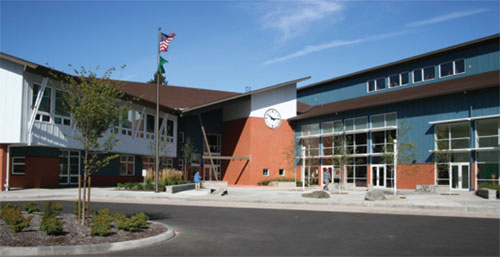Rethinking Wood as a Material of Choice
| LCA IN CODES, STANDARDS AND RATING SYSTEMS |
LCA is more common in Europe than North America, but its use is increasing in both markets because of its holistic approach and power as an evaluative tool. For example: The UK-based Building Research Establishment’s Environmental Assessment Method (BREEAM) is the world’s most widely used green building rating system and the basis for many others, including the Leadership in Energy and Environmental Design (LEED) system and Green Globes. The BREEAM modules for offices, multi-family buildings and ecoHomes include calculations based on LCA. In the U.S., LCA is encouraged in the Green Globes rating system, and included in the American National Standard based on Green Globes, ANSI/GBI 01-2010: Green Building Assessment Protocol for Commercial Buildings. It is also included as a pilot credit in LEED. LCA is incorporated in the draft California Green Building Standards Code, American Society of Heating, Refrigeratingand Air-Conditioning Engineers (ASHRAE) Standard 189.1, National Green Building Standard (ICC 700), and International Green Construction Code (IGCC). |
A comprehensive 2007 review of scientific literature2 looked at research done in Europe, North America and Australia pertaining to life cycle assessment of wood products. It applied LCA criteria in accordance with ISO 14040-42 and concluded, among other things, that:
- Fossil fuel consumption, the potential contributions to the greenhouse effect and the quantities of solid waste tend to be minor for wood products compared to competing products.
- Wood products that have been installed and are used in an appropriate way tend to have a favorable environmental profile compared to functionally equivalent products made from other materials.
It's worth taking a closer look at some of the important aspects that contribute to this favorable environmental profile.
| COST-EFFECTIVE GREEN SCHOOLS | ||
Bethel School District (BSD) is proving that building green doesn’t have to cost a lot. While the District reports an 81 percent ENERGY STAR rating overall, several of their 17 elementary and six junior high schools have a rating ranging from 95 to 98 percent. While size, configuration and age of the 23 facilities varies, one thing remains constant: each is wood-frame. Wood-frame schools can be easily designed to meet and exceed the demanding energy efficiency requirements of environmentally-minded school districts. And, they can do so cost effectively. One of BSD’s new elementary schools, completed in 2011, had a total construction cost of $197.70 per square foot—a significant savings compared to the average construction cost of an elementary school in western Washington, which is $250.07. BSD credits several factors in their success. In western Washington, wood studs cost almost half as much as metal; $0.53 per lineal foot for wood versus $0.98 for metal studs. Also, wood studs don’t transfer heat and cold the way metal studs do, so wood helps improve the energy efficiency of the exterior envelope. Finally, wood-frame walls, floors and roofs easily accommodate inexpensive batt insulation, making it simple and cost-effective to over-insulate. Of their 23 schools and one learning center, 18 have earned the ENERGY STAR label, and the BSD has received national recognition from the U.S. Environmental Protection Agency as an ENERGY STAR Leader.
|
Sustainable Source
Sustainable forest management involves meeting society's need for forest products and other benefits, while respecting the values people attach to forests and preserving forest health and diversity for the future. In North America, responsible forest management ensures that forests are legally harvested and managed to meet society's long-term demand for forest products and other sustainability goals. In the U.S. and Canada, this has resulted in more than 50 consecutive years of net forest growth that exceeds annual forest harvests.3 The rate of deforestation in the U.S. and Canada is virtually zero.4
Wood is also the only building material that has third-party certification programs in place to demonstrate that products being sold have come from a sustainably managed resource. Sustainable forest certification allows forest companies to demonstrate the effectiveness of their practices by having them independently assessed against a stringent standard that considers environmental, economic and social values. As of August 2012, approximately 500 million acres of forest in the U.S. and Canada were certified under one of the four internationally recognized programs used in North America: the Sustainable Forestry Initiative (SFI), Forest Stewardship Council (FSC), Canadian Standards Association's Sustainable Forest Management Standard (CSA), and American Tree Farm System (ATFS). This represents more than half of the world's certified forests.
 |
A study by the Consortium for Research on Renewable Industrial Materials (CORRIM) examined the impacts of comparable wood vs. concrete homes in Atlanta and wood vs. steel-frame homes in Minneapolis (the materials most common in each city). In both comparisons, wood was shown to be better for the environment in terms of embodied energy, air and water pollution, and global warming potential. In terms of solid waste, the wood home outperformed the concrete home, but resulted in slightly more waste (0.9 percent) than the steel-frame home. This table shows the results applied to wall assemblies. |










